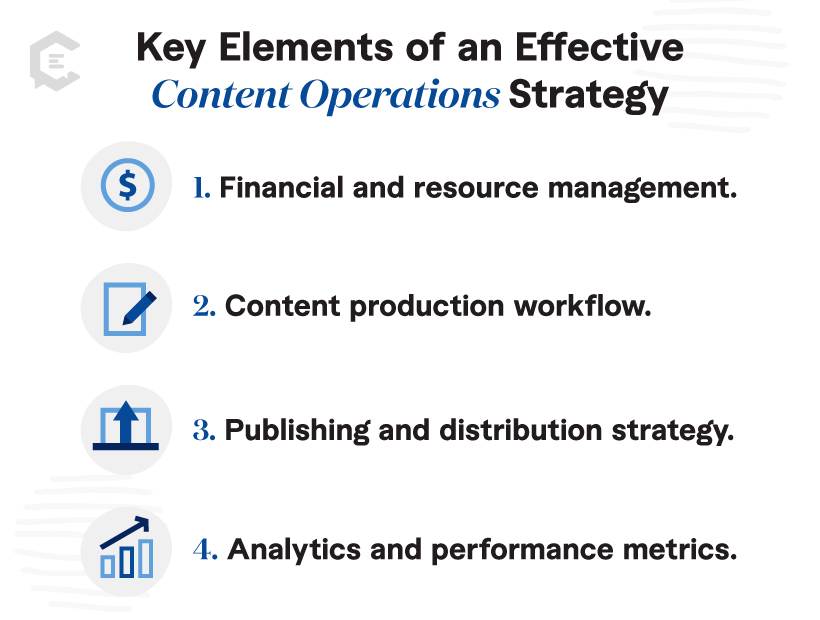What are Content Operations?
Your content operations consist of the collection of processes you use to create content and encompass all the people, systems, and tools you manage to produce, publish, and distribute content. If content creation is the creative, content operations is the structure. An efficient content production operations process will allow you to scale your content without issues like duplicate content, inconsistent quality, and missed opportunities.
On the surface, this might sound like content strategy, but it’s more nuanced than that: your content operations carry out the content strategy itself through systems and processes. It involves the nitty-gritty of turning strategic visions into reality through meticulous planning, coordination, and execution.
This can involve:
- Actionable tasks
- Resource management
- Content production
- A publishing schedule
- Quality assurance
Put another way, content strategy provides the roadmap, while content operations drive the content to its destination.

Why It’s Important to Have a Content Operations Plan
Content operations ensure every piece of your content strategy and management works smoothly. Continuing the car analogy, all of your content systems and processes keep the vehicle on the road. It takes more than a full tank of gas to get your car to its intended destination, and the same is true of content operations for your content strategy.
A robust content infrastructure prevents:
- Inefficiency and delays
- Wasted resources
- Quality issues
- Lack of content relevance and freshness
What do those all add up to? Wasted money.
To be effective with your content (and your budget), you need to have a plan.

Key Elements of an Effective Content Operations Strategy
An effective content operations strategy should have four key elements:
- Financial and resource management: Content operations involve crafting your budget, tracking expenditures, and allocating resources to ensure every dollar spent aligns with your content strategy. Also, optimizing output and efficiency by identifying the most cost-effective solutions and tools and using the right mix of internal and external resources.
- Content production workflow: This is the end-to-end process of creating content and requires well-structured and effective workflows to produce everything efficiently. This includes collaboration and communication across teams and departments, adhering to timelines, and using content management systems (CMS) to streamline processes.
- Publishing and distribution strategy: This outlines how and where content is published. It involves selecting the right channels for distribution, scheduling content releases to maximize reach and engagement, and integrating cross-platform promotional activities to ensure a wider reach.
- Analytics and performance metrics: By regularly reviewing metrics and having the right systems in place, you can gain insights into what types of content work best, which channels are most effective, and how to refine the strategy to achieve the desired impact.

Optimizing Your Operations
In the broad sense, communication and clearly defined expectations will be crucial, especially if you have a large and/or complex organizational structure. Here are some tips to help you streamline your content operations process:
- Utilize a centralized content management system (CMS). Implementing all-in-one operational solutions like a CMS puts all your content-related activities in one place. It can support planning, creation, distribution, and analytics. This will reduce confusion, improve communication, and make it easier to track progress and deadlines.
- Automate where possible. Use technology to automate mundane content operations tasks, freeing your team’s time to focus on more important work.
- Create defined roles and responsibilities. It’s easy for tasks to overlap or get overlooked, especially in a complex organization. Delineating each team member’s role and purpose ensures they know how they fit in the content lifecycle.
- Have a dedicated content operations team or leader. This person (or people) can be your lynchpin, bridging gaps between marketing, sales, and customer service to ensure everything aligns with broader organizational goals.

What If I Want to Outsource My Operations?
We’re glad you asked! When you work with ClearVoice as your managed content solution, we become your one-stop shop for your content creation, production, and distribution. Our platform functions as a well-oiled CMS, and we manage the content team for you! Whether you’re working with a limited team or want to scale up quickly, ClearVoice has the systems and processes you need to run a stellar content operation.
So what are you waiting for? Take the guesswork out of content operations and let a proven team take the reins. Talk to a content strategist today about making ClearVoice your managed content solutions.



